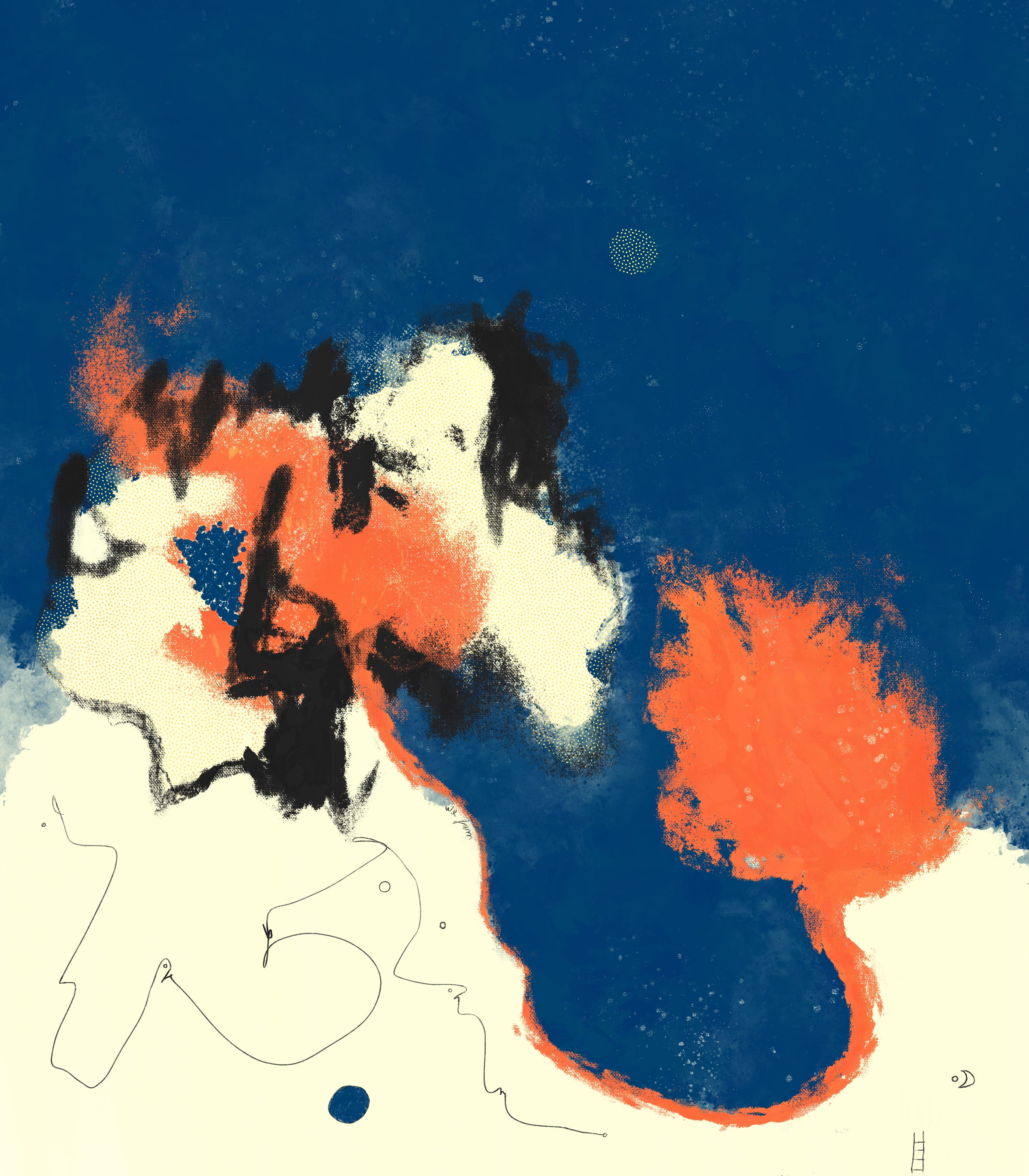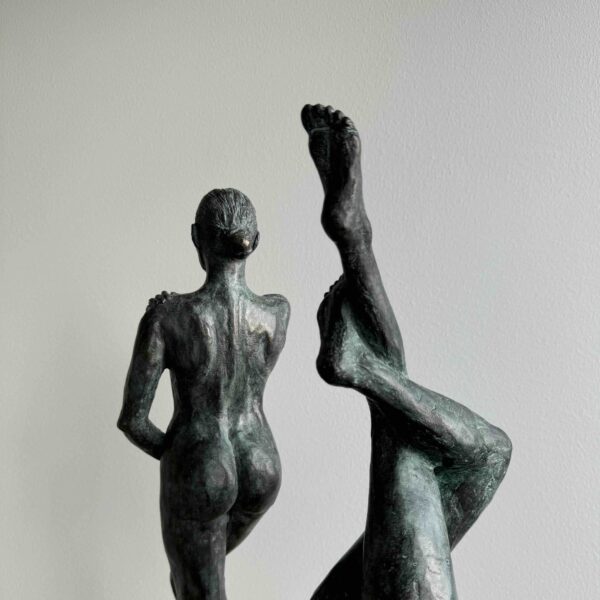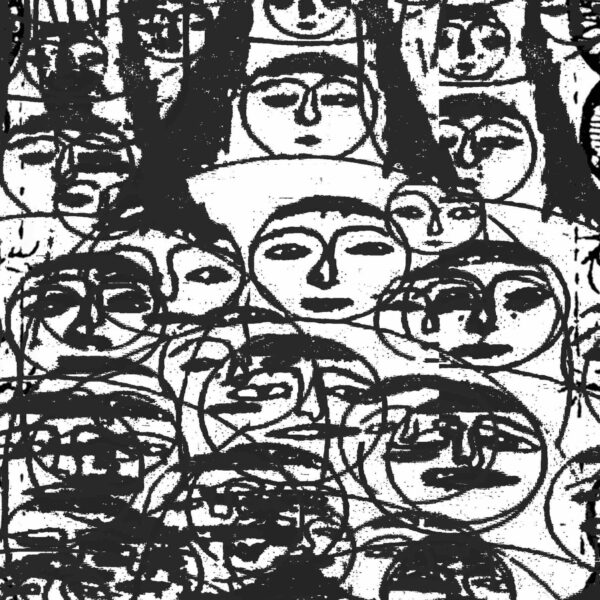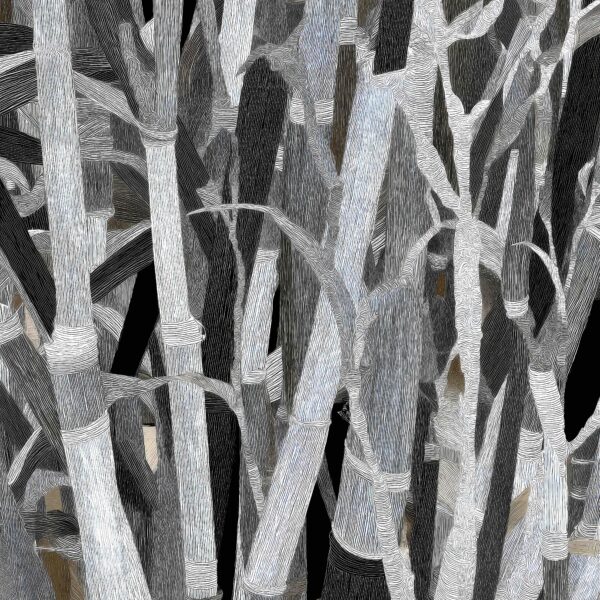Abstract Visuals, Concrete Truths: Exploring Omentejovem’s Poignant Perspective
Omentejovem is a promising young Brazilian artist making waves with his signature abstract, free-flowing visual style. First discovering his passion for art as a child, Omentejovem has honed his craft through years of experimentation and play. Propelled by his chance encounter with NFTs, he has fully embraced his creative freedom as a digital artist. In this interview, we explore Omentejovem's artistic journey, discussing his influences, creative process, and profound mantra "Cheap Problems." Join us as we gain insight into the mind of this emerging artistic talent. Please note, this conversation has been edited for brevity and clarity.

AOTM: Could you share a little about your upbringing and how it has shaped you as an artist?
OMENTEJOVEM: I greatly enjoyed playing with toys and kites as a child. One of my favorite activities was to repurpose the broken parts of kites or other toys to create something new and exciting. One of my earliest and most memorable experiences with art occurred when I was around 11 or 12 years old. I began to draw random lines on a piece of paper during an art class, adding small details like extra lines or circles. This practice allowed for a wide range of interpretations of my work – it could be seen as a bird, a dragon, or anything else one might imagine. This was my first experience with abstract art. One of the most rewarding aspects of this experience was when my classmates asked me about my process, and I attempted to teach them the technique of letting their line flow freely, thus keeping the interpretations open-ended with some intentionality through the addition of circles and other details.
In my mid-teens, I began to experiment with image design for fun using Photoshop. This was a skill I had developed earlier when I was creating skins for a first-person shooter game I played when I was around 14. By the time I was 16 or 17, I was creating album covers and lyric videos for the music industry, primarily for artists from my city.
During this journey, I discovered NFTs and the freedom they could provide me to make a living creating digital artwork as if they were traditional pieces. I had never been exposed to traditional art before; I learned everything I needed to know from Twitter: English, marketing, understanding the markets, ensuring security in crypto, and so on. The Covid-19 pandemic allowed me to focus solely on learning everything about crypto and NFTs, for which there were only a few resources available, such as an article by Loopify.
I found myself increasingly frustrated with having to fit my aesthetics into someone else’s vision, and NFTs provided the perfect opportunity for me to change my path and follow the one in which I truly believed.
AOTM: How did you first get into the art world and what was your first foray as a professional artist?
OMENTEJOVEM: I’d say my first encounter as a “professional artist” occurred when I sold a piece of cover art for approximately $15. Though I have been experimenting with art throughout my life, it is with NFTs that I have been able to do so infinitely more and consistently. NFTs made it all possible, enabling me to maintain a high level of attention and dedication to my craft.

AOTM: What is the story behind your first NFT?
OMENTEJOVEM: I first learned about NFTs through Etiene Crauss, a fellow Brazilian artist. We are part of the same community of Brazilian designers and artists, and his work with NFTs sparked my curiosity about why and how someone would purchase digital art. He sent me some articles (including the first one by Loopify) and gave me instructions to follow. He also sent me some Ether, which was essential for minting my first NFT. This piece sold within a few hours – I woke up to the sale and suddenly everything made sense. The process was simple yet revolutionary. I believe anyone with experience in gaming will understand and embrace NFTs easily and without much concern.
AOTM: Your work is deeply personal and intuitive, with a notable use of color. How did you develop this unique style and what influences have shaped it?
OMENTEJOVEM: My initial works were more linear and featured less color, either due to sparse coloring or areas left unpainted. I thought that was the “standard” for my creations and aesthetic. However, this approach began to make me feel uncomfortable as it restricted my creative freedom. My artwork “the day I found out I can do everything” speaks a bit about this experience. The piece was one of several abstract experiments I began to conduct at a time when I felt constrained by the pressure to maintain a consistent “brand.” I understood that having some standards was necessary to some extent because it shapes the direction and taste of what you’re building.
However, adhering too closely to these standards can eliminate the possibility of ‘mistakes’ or unexpected outcomes in a process, outcomes that can be appreciated and taken to the next level. I enjoy drawing random lines and discovering their potential as I progress. In some of my works, I notice certain complexities that I find difficult to move beyond, while in others, I manage to do it quite well.
I believe the creation process should always be a challenge, with each piece pushing the boundaries of concepts we like and want to explore, but without restricting our creativity and ideas. It’s about personality and our individual perspectives on things, life, and ourselves. I don’t believe a truly great artwork can exist without a personal truth from the artist. This truth needs to be present and continuously renewed in my opinion.
AOTM: As a Brazilian artist, how has your cultural background influenced your artistic approach?
OMENTEJOVEM: Although I believe the vibrant and diverse colors of Brazil may have some influence on my work, it’s honestly a question I haven’t pondered extensively. While I’ve consumed a lot of American culture, such as video games, superheroes, etc., life and lifestyle in Brazil have certainly inspired me. It’s something you just feel, even if it’s hard to put into words.
When I found joy in this process, I knew that this was the right path for me.
AOTM: The ability to translate complex emotions and experiences into a visual language is a powerful skill. How do you navigate this translation process and ensure that your personal sentiments resonate with your audience?
OMENTEJOVEM: That’s an intriguing question. I would say that most of my process is subconscious. I draw random lines until I find one I like and then expand upon it, much like I did when I was 12 years old (though back then it wasn’t as ‘serious,’ it was just a fun process that I loved doing and that ultimately led me back to abstract art). When I found joy in this process, I knew that this was the right path for me.
In my experience, expressing truth is easier than constructing something artificial. I often compare the artwork I create to my own life, or simply try to visualize a sincere emotion. This can happen at any stage in the process – sometimes at the end, sometimes at the beginning, and sometimes it only becomes apparent after a few days or weeks, when I see something personal in the piece.
Of course, this isn’t always the case, but I enjoy extracting personal meaning from my artworks. This can either be through the aesthetics of the artwork itself, or through documenting how I was feeling during the creation process, reflecting the day, year, or phase of my life.
The audience sometimes resonates with the concept, and at other times, they bring their own interpretations, which I personally love. However, sometimes providing a description to document my personal perspective can be interesting. I believe the most engaged viewers are those who personalize the artwork, rather than merely trying to understand “what the artist was trying to do.” They bring their own experiences and interpretations to the work, which is a fascinating process to observe, even though it can be interesting to know the artist’s initial intent.

AOTM: The concept of ‘play’ is often considered a crucial element in fostering creativity. How does the element of play factor into your artistic process?
OMENTEJOVEM: The element of ‘play’ is absolutely vital to my artistic process. Without it, the work can become monotonous, even during its creation. While it’s true that worthwhile results can sometimes emerge without the ‘play’ factor, I believe that being playful and enjoying the process is the ideal state for allowing ideas to flow and for sparking innovation.
AOTM: Can you tell us more about the creation of ‘Cheap Problems’? How did you cope with such a personal crisis, and what role did art play in this process?
OMENTEJOVEM: The entire concept of ‘Cheap Problems’ came to me during a bus ride back to my hometown to see my father after his heart attack. I needed a way to detach myself from reality for a while and pass the time until I returned. I love my father and I am grateful for everything he taught me, even when it seemed I was just listening out of respect. Many of the lessons he imparted have helped me learn and become more judicious in my actions under various circumstances.
AOTM: You’ve mentioned that ‘Cheap Problems’ has become a personal mantra for you. Can you expand on this and share how it has changed your perspective on life and art?
OMENTEJOVEM: Yes, ‘Cheap Problems’ has become a ‘mantra’ for me in the sense that it’s a thought I want to hold onto as long as possible. Engaging in activities I love and enjoy, expressing and receiving love from those around me – these are the aspects of life that truly matter. Everything else, by comparison, is ‘cheap.’ The value lies in what we feel and what we make others feel.
The element of 'play' is absolutely vital to my artistic process. Without it, the work can become monotonous, even during its creation. While it's true that worthwhile results can sometimes emerge without the 'play' factor, I believe that being playful and enjoying the process is the ideal state for allowing ideas to flow and for sparking innovation.

AOTM: Can you tell us more about the creation of ‘Cheap Problems’? How did you cope with such a personal crisis, and what role did art play in this process?
OMENTEJOVEM: The entire concept of ‘Cheap Problems’ came to me during a bus ride back to my hometown to see my father after his heart attack. I needed a way to detach myself from reality for a while and pass the time until I returned. I love my father and I am grateful for everything he taught me, even when it seemed I was just listening out of respect. Many of the lessons he imparted have helped me learn and become more judicious in my actions under various circumstances.
AOTM: You’ve mentioned that ‘Cheap Problems’ has become a personal mantra for you. Can you expand on this and share how it has changed your perspective on life and art?
OMENTEJOVEM: Yes, ‘Cheap Problems’ has become a ‘mantra’ for me in the sense that it’s a thought I want to hold onto as long as possible. Engaging in activities I love and enjoy, expressing and receiving love from those around me – these are the aspects of life that truly matter. Everything else, by comparison, is ‘cheap.’ The value lies in what we feel and what we make others feel.
AOTM: Throughout your artistic journey, what is one piece of advice you’ve received that has had a significant impact on your career? How did it shape your path and what you’ve accomplished?
OMENTEJOVEM: I’m forever grateful to Ben (@__DeFi__) for believing in my work when I initially sent him a direct message about it. Our ongoing conversations have been invaluable because I’ve been able to engage with someone willing to listen and exchange ideas. This exchange helped me better understand the market and the strategy behind thoughtful art releases, among other things. I am also appreciative of all the collectors who have shared their knowledge with me. Some of them have become sounding boards for my ideas, and their perspectives have been instrumental in helping me make informed decisions. While creating art is one aspect of the work, understanding how to position yourself in the market is another. These two elements don’t necessarily intersect – in my opinion, if they do, the art might suffer. It’s vital to keep the joy of creation separate from business strategy so as not to compromise your vision and creativity.

AOTM: Artists often face periods of self-doubt and creative blocks. Could you share any strategies or practices that you have developed to navigate these challenges and maintain your creative momentum?
OMENTEJOVEM: I once took a series of classes on creativity with an insightful teacher. One of the key takeaways from those sessions was that creativity stems from curiosity and hard work. You don’t need to wait for inspiration to produce great work; just get started, and creativity will find you in the process. Consistency, hard work, and discipline are essential. Producing art while inspired is wonderful, but creativity is about connecting points A and B, handling information in your own unique way. When facing a creative block, you can try various strategies – do nothing, learn something new, or find a purpose for what you’re doing and stick to it with discipline.
AOTM: Looking forward, where do you see your art heading in the next few years? Are there any new themes or techniques you’re excited to explore?
OMENTEJOVEM: I’m very confident in my abilities, and I believe I can reach places that I don’t even know exist yet, as long as I’m working on what matters most – art. I’m thrilled about venturing into new territory, like creating clay sculptures for my home and designing furniture with friends, as well as producing physical art in my current atelier/studio, which is under construction.


